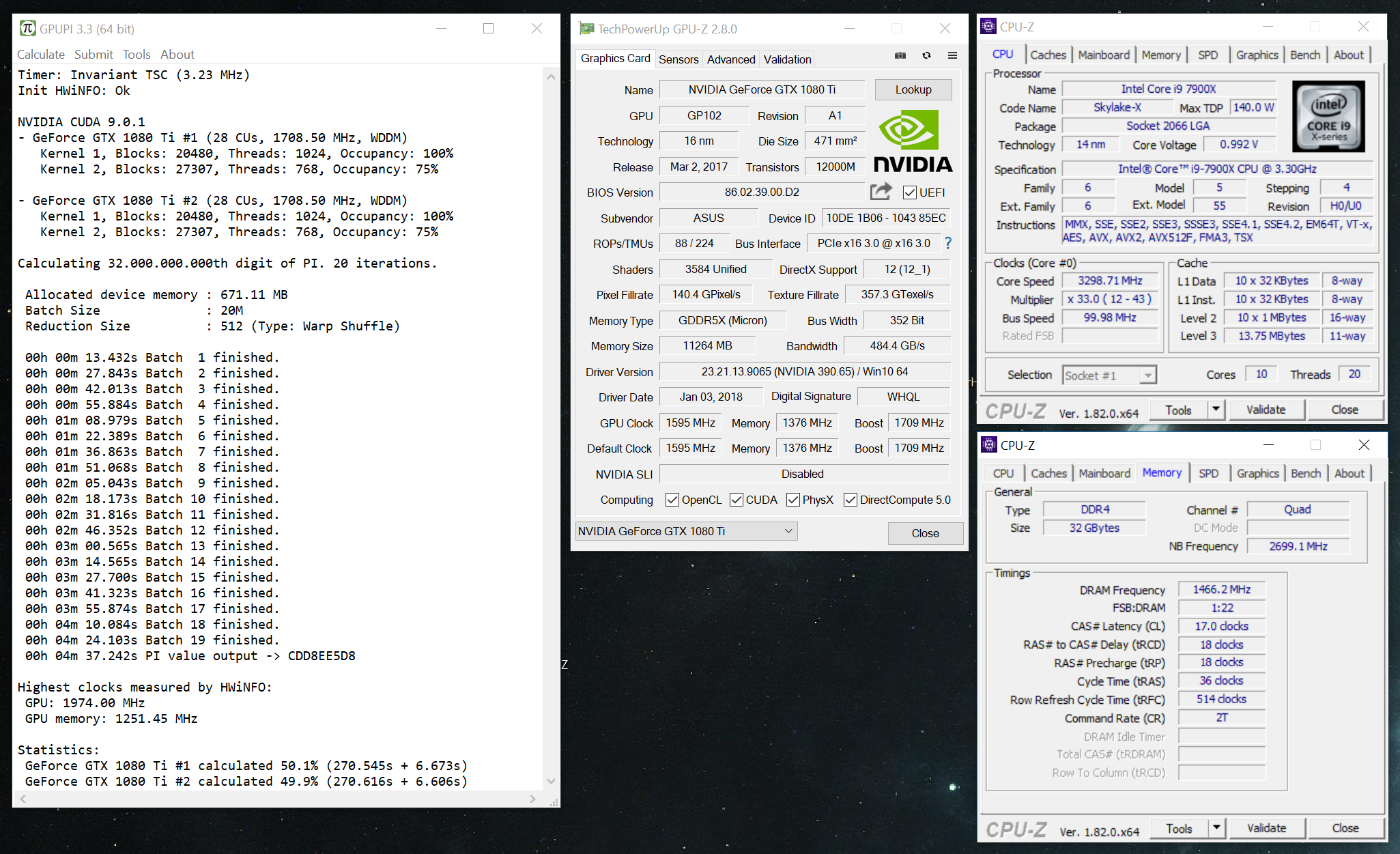-
Posts
1003 -
Joined
-
Last visited
-
Days Won
41
Content Type
Profiles
Forums
Events
Blogs
Posts posted by _mat_
-
-
And it has to be enabled in Windows, see the GPUPI FAQ section again, you'll find a command line statement to switch to HPET.
But that has nothing to do with your problem. It's just a more precise timer, but only for a few ms of the measured end time.

-
Unless that service kills your memory bandwidth, it should cause no trouble. Try other memory benchmarks as well to see if the performance is en par. I am still leaning more towards a hardware problem, not a driver or software issue.
Also have a look at your NB frequency, 5900 MHz is very high.
-
Your reduction time is completely off, that's the second time listed in the statistics. Others have about 10 seconds, maybe 15, yours is 87 seconds.
So check the memory for faulty reads and writes, maybe it's overclocked too high.
-
Post the score please, I'll have a look.
Btw, normally you should not use the Intel OpenCL drivers. Use the AMD OpenCL drivers, they are much faster on Intel CPUs as well. If you don't know how to install it, please take a look at the GPUPI international support thread: https://www.overclockers.at/news/gpupi-international-support-thread
There is a FAQ section that has a link to the AMD APP SDK, if you don't have an AMD graphics card.
-
What's your Intel OpenCL driver version? Any special batch or reduction sizes or is everything at default (20M, 256)? I currently can not reproduce the error.
-
Awesome job, congrats!
-
That's exactly how it's already done. I've discussed this with Massman as well before launching the multi GPU version. It's also easy to prove: The statistics listed after the result give insight into the performance of each GPU. For automatic submission with successfully detected GPU, the benchmark already does this on its own.Only my sugesstion, choose the highest graphic card you have in the system, like 2x4870 + 4890 = 3x4890. It's the risk for not having exactly same GPU.I think it's the best option by far, also for DX12 benchmarks coming soon. Otherwise there could be a "nobody cares about your GPU configuration" category, but I guess that won't be too exciting for slower and older cards.
If it helps, I can add more information about this rule inside the benchmark. But this should be properly discussed and officially enforced as soon as possible. GPUPI won't be the only benchmark to allow mixed cards in the near future!
-
Glad you got it working and nicely done as well!

You have to run the wrapper with administrator rights to call bcdedit, am I correct? That's why I decided to just give a link to my FAQ section.
-
If the detection is saved within the file, there is no way to undo this without having the private key to decrypt the data. And HWBOT will hate you for submitting CPUs or GPUs that can not 100% be matched with the database, and therefor neclect you like you never ever benched a single system.so when do you save a file with it will it eventually work even if it doesnt now?It's a dangerous game, so when benching new or strange hardware better skip the detection.
-
No kernel mode driver necessary. Just avoid certain timing methods on some windows version to avoid clock skew. I introduced this with GPUPI 2.1 and wrote a small article including some tests: https://www.overclockers.at/articles/gpupi-2-1I can't find a way to detect the HPET directly. At least not without kernel mode drivers. But there is a way to do it heuristically from user space with normal access privileges. Unfortunately, it will be a while before I can fully test this. Both of my test machines have ASUS motherboards which don't have a BIOS option to disable the HPET and force Windows to use something else. And the only Skylake system I have is a gaming laptop (overclockable, but with limited options).One thing that makes things more complicated is that Windows doesn't consistently use HPET even when it is available:
- On my 4770K and 5960X, Win7 doesn't use it.
- Win8 uses it by default on my 4770K.
- Win10 doesn't on both my 4770K and 6820HK.
(I haven't yet checked to see what happens on my FX-8350.)
If I do a blanket requirement that HPET is enabled, then all systems which are ok without it (Win7, Skylake) would be collateral damage and a major inconvenience to turn it on. From a usability perspective I can add a button that will create a script that runs the bcdedit command to turn on HPET. But come on... A program that creates scripts which run themselves as admin and modifies the BCD? Sounds totally harmless. That will have absolutely no issues with virus scanners. None at all...

Right now v0.7.1 has OS detection. So I can whitelist all of Vista and Win7 and require a hardware reference clock for Windows 8/8.1 and 10. But there's no detection for Skylake. And then there's the question of Linux. (Which I'm not even gonna try to solve since it's open sourced and anyone can just modify and compile their own kernel.)
At this point we're well into the territory where anything that is built will probably fall apart on the next generation of hardware or software updates. So looking forward, I'll need to design this "reference clock sanity check" in a way that can be reconfigured on short notice.
Whatever the case is, I'm not going to write a kernel mode driver. That's a big can of worms and it's not my area of expertise. Furthermore, it's too invasive. I'm already lifting the privilege elevation for v0.7.1 and I really don't want to revert on that.
Let me know if you need any kind of help. And keep up the good work!
- On my 4770K and 5960X, Win7 doesn't use it.
-
The detection of AMD graphics cards is sometimes off, because they relabel the cards with the same GPUs and Compute Units and do not expose the name of the model itself within the APIs.
But this could be a bug in GPUPI, because the R9 285 has a different CU count than the R9 380X, although both are shown with the codename Tonga. I will have a look at this and fix it, if necessary.
Until then please uncheck the "GPU detection" on the submission dialog. This will send you to an intermediate site on HWBOT, where you will be able to enter the graphics card manually.
-
You are running 100M on the GPU, which is fine but not a HWBOT category. Select 1B or 32B for graphics cards and 100M and 1B for CPUs. After a valid result the menu items for submission will be unlocked.
-
Funny combination of cards! A few pictures would have been nice.

-
6.4 with 1.95 volts? Bunny yeah!
-
Awesome project and congrats for the well earned world record!
-
Invalid result means your hardware is not stable. Even the slightest miscalculation in the first 27 decimals in just one of the billions of partial calculations can output the wrong result. Sometimes I wonder that it even works so well with overclocked cards.

-
Awesome mixture! Finally somebody is using the flexibility of GPUPI (or GPGPU in general) to get more points.

-
As I said, GPUPI has no access to clock speeds, let alone manipulate them. But there is of course always the possibility that the OpenCL or CUDA driver of the card is involved in this and enables another speed step, that is not set up correctly.
Please post a screenshot of Afterburner showing the problem and a comparison to another windowed 3d application like Furmark. I am sure we can get to the root of this problem.
-
Those aren't GPUPI specific issues, the software (currently) can't control any of these clock speeds. I guess the downclocking happens on any kind of load, if you measure it in the background with Afterburner.
-
What batch size are you using?
-
100M is only for CPU, you are running the benchmark with GPU.Hi thanks for the response - I think * im doing this correctly and attach some images - The HPET doesn't seem an issue as the card is identified. following the running suggests calculation is complete but going to HWBOT *(image 3) is greyed out... Any help appreciated - Trying to submit to rookie #23

-
I've uploaded it for you: https://www.overclockers.at/downloads/capture.zip
-
You have to complete a run using a category that is represented in HWBOT. That is:Hi, the HWBOT submit online and save data file are greyed out - windows 10 please could someone help ? thanks in advanceCPU: 100M or 1B
GPU: 1B or 32B
All other categories won't allow you to save or submit a validation file.
Is not need to be enabled the HPET setting on Win8/Win10 systems in order to get validated score?Without HPET you can't complete a benchmark run on Windows 8 or 10. There will be a startup error.
-
Glad to hear that you got it working!
I am currently very busy doing overclocking shows at a local gaming exhibitions, but as soon as I am done, I will compile the latest version with debug symbols and send it to you.


GPUPI - SuperPI on the GPU
in Benchmark software
Posted
What do you exactly mean with crashing? Runtime assertion? Please specify the exact error message and have a look at GPUPI.log as well.
A wrangled OpenCL driver is btw much more common to produce such an error. Please uninstall any driver and reinstall again.